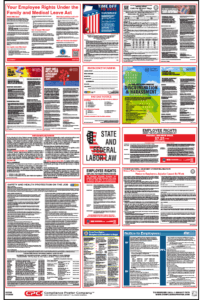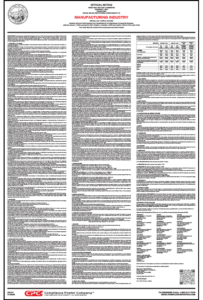 On January 1, 2018, the minimum wage increased in 18 states, an even greater number of municipalities, and on the federal level for employees of federal contractors. Employers were required to pay employees at the updated hourly wage rate and, in many cases, update their outdated workplace posters with a 2018 minimum wage poster.
On January 1, 2018, the minimum wage increased in 18 states, an even greater number of municipalities, and on the federal level for employees of federal contractors. Employers were required to pay employees at the updated hourly wage rate and, in many cases, update their outdated workplace posters with a 2018 minimum wage poster.
While most employers operating in these regions (hopefully!) knew that a wage increase was coming for them, some may have been surprised at the size of the wage hike once it arrived, especially compared to neighboring states. Why are some states jumping up by $1.00 or more, while others only increase by a few cents? How can you predict the next wage hike in preparation for 2019? When is a poster update necessary?
Method in the Minimum Wage Madness
Minimum wage increases can generally be separated into two categories: scheduled or inflation-based. States that want the minimum wage to hit a specific target (such as $15 or $12 per hour) will usually create a schedule to gradually increase the minimum wage each year until the goal is met. 10 of the 18 states that increased their minimum wage on January 1 were following a legislatively-determined schedule.
After voters in Arizona passed a minimum wage and sick time ballot initiative in 2016, the state minimum wage rose from its previous rate of $8.05 to $10.00 on January 1, 2017. That first increase was a pretty big hike, because voters felt that the minimum wage had fallen seriously behind the needs of the community. In the years following, though, the minimum wage will take smaller jumps until it hits $12.00 per hour in 2020. Starting in 2021, the Arizona minimum wage will be adjusted each year for inflation in the hopes that a big minimum wage hike won’t be needed again.
Like Arizona, many states chose to adjust their minimum wage for inflation – a sustained increase in the cost of goods and services – after a series of scheduled increases. Inflation-based minimum wage models ensure that the purchasing power of workers remains stable even when the cost of living goes up.
The U.S. Bureau of Labor Statistics computes a monthly Consumer Price Index (CPI) to track aggregate price changes for various regions, types of items, and types of consumers. The majority of states operating under an inflation-based minimum wage model adjust the minimum wage for increases to the national Consumer Price Index for Urban Wage Earners and Clerical Workers (CPI-W), although there are some variations and exceptions. Generally speaking, an inflation-based minimum wage results in smaller increases than a scheduled minimum wage. Additionally, if prices remain relatively stable during the time measured, the minimum wage will not increase at all.
Alaska’s 2014 Wage and Hour Act scheduled minimum wage increases for 2015 and 2016. Beginning in 2017, Alaska’s minimum wage must be adjusted each year for increases to the CPI for Urban Consumers in the Anchorage metropolitan area over the proceeding January-December calendar year. For 2018, Alaska was required to adjust the minimum wage for inflation during the 2016 calendar year, resulting in a $.04 increase to the state minimum wage.
January 2018 Minimum Wage Table
You can use the table below to see which model your state is operating under so you know what to expect for next year. In the case of scheduled minimum wage increases, you can see the end-point of the schedule, as well as whether the state stops increasing or switches to an inflation-based model once the goal has been reached. The table will also let you know if a 2018 minimum wage poster update was required for your state, or if other poster updates are needed.
| Scheduled Minimum Wage Increases | Inflation-Based Minimum Wage Increases |
Arizona
|
Alaska
|
California
*Other 2018 updates required, see here for more details |
Florida
|
Colorado
|
Minnesota
|
Hawaii
*Other 2018 updates required; see here for more details |
Missouri
|
Maine
*Additional 2018 updates required; see here for more details |
Montana
|
Michigan
|
New Jersey
|
New York
*Additional 2018 updates required; see here for more details |
Ohio
|
Rhode Island
|
South Dakota
|
Vermont
*Other 2018 updates required; see here for more details |
Federal Contractor Minimum Wage
|
Washington
*Other 2018 updates required; see here for more details |
2018 Minimum Wage Poster Updates: What To Remember
When multiple minimum wage laws are in play, an employer must pay employees the highest minimum wage rate in operation for the location at which those employees work. However, other provisions of the minimum wage laws are still in effect, so employees must be notified of their rights under the law at each level: federal, state, and local (city and/or county).
 For example: an employer operating in the city of Palo Alto, CA must pay employees working in the city the local minimum wage rate of $13.50 per hour, because it is higher than both the minimum wage rate for California and the federal minimum wage rate. An employer with employees working in the city is required to post the Palo Alto Minimum Wage Poster in the workplace.
For example: an employer operating in the city of Palo Alto, CA must pay employees working in the city the local minimum wage rate of $13.50 per hour, because it is higher than both the minimum wage rate for California and the federal minimum wage rate. An employer with employees working in the city is required to post the Palo Alto Minimum Wage Poster in the workplace.
 Employers also must post the Employee Rights Under the FLSA poster (a.k.a. the federal minimum wage poster) and the California minimum wage poster to remain in compliance with state and federal law. CPC’s California All-On-One™ Labor Law Poster consolidates all state and federal mandatory-to-post requirements, including both the state and federal minimum wage postings, on one poster to make posting compliance quick and convenient.
Employers also must post the Employee Rights Under the FLSA poster (a.k.a. the federal minimum wage poster) and the California minimum wage poster to remain in compliance with state and federal law. CPC’s California All-On-One™ Labor Law Poster consolidates all state and federal mandatory-to-post requirements, including both the state and federal minimum wage postings, on one poster to make posting compliance quick and convenient.
 In addition, California employers must post an Industry Wage Order (IWC) to inform employees of regulations governing specific industries and occupations. New Jersey and New York also mandate industry wage orders for some employers.
In addition, California employers must post an Industry Wage Order (IWC) to inform employees of regulations governing specific industries and occupations. New Jersey and New York also mandate industry wage orders for some employers.
Employers should also keep in mind that some states and municipalities increase their minimum wage on July 1 rather than January 1. Maryland, Nevada, Oregon, and the District of Columbia each have a minimum wage update scheduled for July 1, 2018, as well as a handful of cities.

